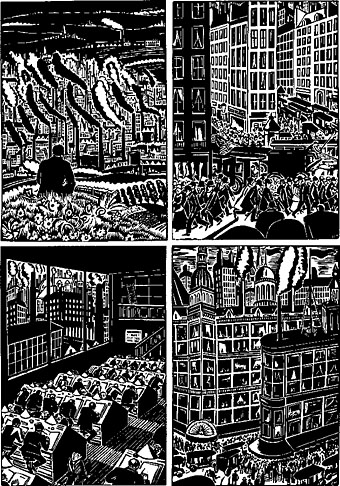Pages from Die Stadt (1925), a “novel in woodcuts” by anarchist artist Frans Masereel (1889–1972). See the other ninety-six pages here. And by the same artist, Die Idee.
A pacifist in World War I, he tried to make his art accessible to the ordinary man. His works were banned by the Nazis and widely distributed in Communist countries. But he rejected “political” art and party affiliation, condemning all enslavements, oppression, war and violence, injustice, and the power of money.
Elsewhere on { feuilleton }
• The etching and engraving archive


Masereel was brilliant. I’ve got a few of those lovely Redstone Press editions: The City, The Sun and The Idea. Amazing work.
Actually, I guess he would have been one of Barney’s influences.
I’ll have to see about ordering a copy of this from somewhere.
Masereel may well have been an influence on that Imperial Pompadours sleeve; Picasso certainly was, judging by the facial style and BB having done a Picasso pastiche around the same time.
Masereel is one on the great unknown artist of the 20th century. The fact that he is a book illustrator rather than a “fine artist” has held his status back. His best work done between the wars is a brilliant and insightful, a mirror of the human condition. I find it amazing that he was able to at once be so prolific and yet be profound at the same time.
I have a large collection of his signed first editions which are still reasonably priced and are superior to the later reprints. The originals are time capsules of a period when political activism meant something and was not drowned out by K Street spin.